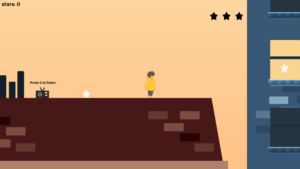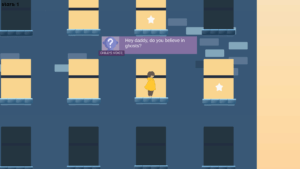GHOSTLY STARS
BY JANICE, CHARLOTTE, KATHERINE, CONNOR, STEVEN, AND SHIMEA
ARTIST STATEMENT
We set out to make a game that is simultaneously innocent and dark. When we imagined a child jumping on residential buildings to chase the stars, we thought: what if the stars are just reflections of the city lights below? What if the child is dead, dead from a jump to chase the stars and this is his afterlife?
GHOSTLY STARS is a game that consists of jumping on windows, balconies, electrical lines, and clouds, and collecting stars along the way to open up secret platforms, in an attempt to get higher and higher towards the ‘stars’. Along the way, the child hears dialogue from the residents living inside apartment complexes, everything from a mom yelling at her son to step away from the balcony to a girl asking her dad about believing in ghosts, in order to tell the story of what happened and what is left in its wake.
By mixing childlike wonder with the reality of death and sudden loss, we hope to create a game that is not only intellectually and mechanically challenging from our platformer puzzles but that is also tender, sad, uncanny, and hopeful.
INITIAL DECISIONS ABOUT FORMAL ELEMENTS
Because the game is about a child chasing their dreams of reaching the stars through jumping on residential complexes, we decided to make the game a single-player vertical platformer. To add to our theme of stars and childlike imagination, we added “special platforms” which are platforms that only appear once the child has collected a certain amount of stars. This would also add an element of challenge as a form of fun in the game and also encourage the player to explore more of the space. Additionally, we wanted a strong narrative element in order to increase immersion. In particular, by creating jarring narrative turns, such as the child being a ghost and the stars being a reflection of the city lights against water, we hope to suspend the player in a fantasy that is surprising, uncanny, and, in a way, poetic. Through dialogue from people in the residential buildings, the narrative of how the child died and the impact it left on the residents is propelled in a subtle way. The dialogue and art would work together to set an unsettling and tender tone for the game. Due to this tone, our target audience are people aged 13+.
OTHER GAME ELEMENTS
PUZZLE DESIGN
We designed the layout of our platforms with game architecture and space in mind. We wanted to make sure that players had a strong sense of space in the game despite only being able to see a portion of it at a time. Additionally, by paying attention to the layout of our platforms, we could add another type of challenge on top of the traditional motor challenge of platformers, which was intellectual challenge. To think about how to get to place a to place b (which could involve going backwards or downwards or first unlocking the invisible platforms) would keep the player engaged in a new way.
We also wanted to add other puzzles other than platformers. We add an electrical line on which the child can walk on (unless a spark is underneath them) in order to get from one building to another; in this way, game architectural progression can be more fun. We also add clotheslines that the child can also walk on, a paper airplane the child can ride, and a puzzle involving a dog and a radio (essentially, the child must turn on the radio to distract the dog so they can jump on the window without being caught by the dog!). These other puzzles add dynamism to the game by increasing the player’s sense of discovery and challenge, as well as contribute to the residential, city-like theme of the game.
VISUAL DESIGN
Our visuals are grounded in the real-life look of residential buildings in cities, yet we also wanted to touch the art with a hint of surrealism to reflect the imaginative nature of the child; therefore, the art isn’t completely life-like. Additionally, throughout the entire game, we wanted to create a transition from a happier palate to a darker one in order to reflect the child’s slow realization that they are dead and a ghost. Not only does the background reflect this realization but the child themselves do by looking more-and-more ghostlike. In this particular slice that occurs ⅔ into the game, the sky and the windows, lit up, reflect dawn.
SOUND
Background score: In the same way we want the visuals to become darker throughout the game, we also want our music to become darker. For this particular slice that occurs around 2/3rds into the game, we chose an original soundtrack made by a friend that highlights the celestial element in the game through a steady beat, sparkles of high notes, and a lush undertone.
ONBOARDING
In order to onboard players, we have a radio set near the player’s starting point that they can interact with. By doing so, they’ll be able to listen to DJ Tutorial and all of the tips that he has to give on basic controls. Despite platforming games having very similar controls, we want to make the game accessible for people who haven’t played a platformer game before. Additionally, this onboarding message sets the spark for the narrative that will be slowly unraveled throughout the game and introduces the mechanic of collecting stars to make platforms appear.
Additionally, we have two special controls: [s] for going straight through certain special platforms and [space] or [enter] for continuing through dialogue. We introduce these controls through onboarding messages that pop up when the special platforms and the dialogue are introduced for the first time. We want to show information only when it is relevant so as to not overwhelm the player in the beginning.
NARRATIVE
The narrative of the game centers around a child who died by falling off of a balcony in an attempt to chase their dream of reaching the stars only to realize the stars are just reflections of the city lights against a body of water. Now, they are a ghost at the bottom of the residential building, though they don’t know they are a ghost yet or why they’re there other than the burning desire to climb up and up. The player does not know this either. Through dialogue between residents that the child overhears as they jump past their windows, the child and the player uncover the central narrative. We chose to deliver the dialogue that would reflect the conversations that might happen if a situation like this were to occur in real life. Here is a sampling of the dialogue we have written for the game as a whole (though some of these won’t make the slice).
EXAMPLE 1
MPC1: James, don’t go on the balcony.
MPC2: But, mommy, you can see the plane from here. It’s a 737!
MPC1: It’s not safe, dear.
MPC2: (Sighs)
MPC1: I love you, James.
EXAMPLE 2
MPC1: Hey daddy, do you believe in ghosts?
MPC2: No.
MPC1: Why not?
MPC2: I believe that once you die you leave the world entirely. It would be sad to linger here, not fully alive.
MPC1: Do you go into the sky when you die then?
MPC2: Maybe. Somewhere.
MPC1: (starts crying)
MPC2: What’s wrong?
EXAMPLE 3
MPC1: Can we sleep in the same bed?
MPC2: Of course.
MPC1: I’m exhausted.
MPC2: I know. It’s been 60 hours. Let’s get some sleep.
MPC1: I’m scared to sleep. What if he disappears for good? What if we forget?
MPC2: We won’t.
MAP OF GAME

MAP OF LEVEL DESIGN
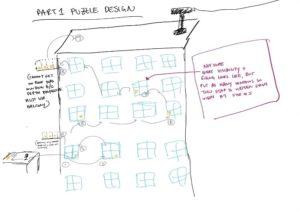
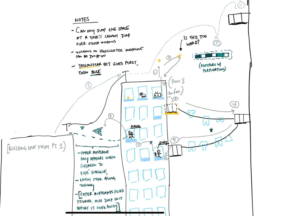
PLAYTESTING
PLAYTEST 1
For our first playtest, we used a template 2d platformer in order to drag-and-drop platforms for players to jump on. We then described the narrative of the game and where we hope to go with it since many of the puzzles and artwork hadn’t been developed at this stage. The main questions we were trying to test were these: do testers enjoy and understand the physics of the template 2d platformer, and how do testers enjoy the platforming experience along with the narrative of the child being a ghost and wanting to reach the stars?
Through observing our two playtesters, we found that users felt something was off with the gameplay of the template 2d platformer. They were struggling to get a feel for jump heights and movement speeds and generally had a very difficult time completing the slice. Additionally, we discovered that we wanted to be more creative with the layout of the platforms. While the platforms took us a long time to create, users were able to work through it fairly quickly. Finally, users seemed to approve of the narrative of the game, but wanted the aesthetics to better match the story in future iterations.
In order to respond to the feedback of the playtesters, we decided to depart from the template 2d platformer, and build a game from scratch in order to have more control over the layout and the physics of the world. Additionally, we decided to draw-out and thoroughly design the placement of each and every platform and star in order to make sure game-play was interesting, intellectually stimulating, and dynamic.
PLAYTEST 2
For our second playtest, we tested a game built from scratch and introduced two new mechanics: one-way platforms in which players can drop by pressing [s] and platforms that only appear after a certain number of stars are collected. The main questions we were trying to answer were: how does the player respond to the two new mechanics and do they contribute to challenge as a form of fun for the game? We also tested the narrative of the game by showing the playtester dialogue scripts that we have. We wanted to see if the dialogue scenes elicited the emotions of tenderness, curiosity, and a dismantling feeling.
The playtester overall seemed to be immersed in the game, wanting to replay the game until they got to the top. The playtester really enjoyed the new mechanics. Additionally, we received positive feedback about the dialogue, with the scene about ghosts being especially highlighted, which showed that the more subtle and orthogonal the conversations are, the more interesting it is for the player; therefore, we tweaked our dialogue to be not as on-the-nose.
From our perspective, the game seemed to go pretty smoothly, with the challenge of motor control being the central core of the game. However, we thought this was too simple. The path upwards was very clear and the player didn’t struggle at all about where to go next. We appreciated them having this flow, however we decided we wanted to design the level to make it slightly more difficult so that the game isn’t just about motor control but also about thinking about how to use the one-way platforms and star collection mechanics in order to get to the top.
Finally, the playtester commented on the art of the game not quite matching the atmosphere of a dead ghost-child. While we hadn’t yet implemented art into the game, it made us extremely aware of art moving forward. We wanted to make sure that we capture the wonder and imagination of a child, along with the surrealist nature of ghosts and the afterlife.
PLAYTEST 3
For our third playtest, we tested our game with two playtesters with two significant changes: 1) a more sophisticated platform layout design, where stars and platforms are more dispersed to encourage more exploration of the game space, and 2) art implementation. In particular, we were interested in seeing how a new platform layout would impact the difficulty of the game and how the art affected the immersive experience.
The biggest takeaway of this playtest was that both playtesters did not understand the star mechanic. From the prior playtest, we assumed players would automatically understand that after collecting a certain amount of stars, a platform would appear. However, because the layout was different and forced players to go out of their way to collect stars, this mechanic didn’t become intuitive anymore, with both playtesters saying they didn’t know that collecting stars made platforms. On the other hand, both playtesters said they enjoyed the art, especially the lines drawn to indicate movement, but encouraged us to make unlit windows darker to increase differentiation.
In order to respond to this round of playtesting, we decided to add one more line to our onboarding page, which says: COLLECT STARS TO MAKE PLATFORMS APPEAR, and darken the windows.
ITERATIONS OF OUR SLICE
EARLY BUILD
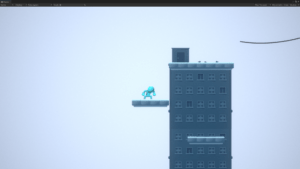
MIDPOINT BUILD
FINAL BUILD
FINAL PLAYTEST OF OTHER GAMES
KATHERINE – SANDBOX
I greatly enjoyed playing Sandbox, a miniature escape room with narrative elements of survival and dystopia. For my feedback, I mentioned that I thought the game is incredibly innovative. I enjoyed tinkering around with the box and seeing a small-scale model of things. I thought the puzzles were easy but not obvious – a combination that was nice! In particular, I liked the use of blacklight in both parts of the game.
I mentioned that the layout of the web pages could be better scaffolded and documented. Especially for the second miniature escape room, I got lost with the back buttons and which links linked to other links. In the end, I got confused about what I was supposed to do! Creating a system where the interlocking and dynamics of the links are more intuitive would be game-changing. Additionally, I thought the use of electronic knobs was innovative. Due to an issue with resetting on their end, I ended up spending around 5-10 minutes figuring out how to make it work to no avail. While this issue was more of a bug rather than a problem with the game fundamentally, I believe thinking through what kinds of hints or instructions they could give when people get stuck would be particularly helpful.
Overall, it was such a fun and innovative game!
JANICE – MODERATOR OF GHOSTLY STARS
During the playtesting session, I moderated Ghostly Stars—our game—alongside Charlotte, who was our notetaker. While moderating, I tried to tell the players as little as possible, letting them wander around and play with keys on the keyboard as they saw fit. While most people got the hang of the game fairly quickly, many struggled to notice the star mechanic: most players had trouble noticing that their star counter was increasing, let alone the fact that new platforms would appear when enough stars were collected.
If players were struggling with figuring out the mechanics (whether in movement or in the star platforms), I lended a little bit of direction. However, I did my best to stay silent as they played the game to see what areas we would need to focus our onboarding efforts on. Moderating the game was almost a wakeup call: I had forgotten that some individuals had zero experience with video games, and wouldn’t immediately reach toward “wasd” and spacebar. While I’m used to exploring games to the fullest and trying to discover the secrets hidden in every nook and cranny of a game, I didn’t realize that a lot of people would simply just try to find the most linear direction toward the end goal. These wakeup calls helped immensely with our development of the onboarding process of the game, and we took everything that the players struggled with into account.
CONNOR – BOTANIMALS
Botanimals was a very interesting game; in my opinion, it was like Hades meets Plants vs. Zombies. I really enjoyed this concept. The team had very ambitious goals for the game–they made three distinct phases in the game!
The best and most polished phase was the battle phase. This is where the player is fighting the evil apples alongside their Botanimals. My initial thoughts for the team was that there was limited visual feedback to indicate what is happening. I could not tell what exactly (if anything) the Botanimals were doing. I also thought the projectile speed of the hose was slightly slow. Upon a second playthrough, I amended my comments about not knowing what the Botanimals were doing. It turned out that I was not paying close enough attention, and I was not coming close enough to them to trigger their powers.
The other phases of the game are buying the seeds that turn into Botanimals, and tending to your Botanimal farm during the daytime. These scenes were significantly less polished than the battle phase. There were some bugs involving movement, and resource permanence. However, I still got the jist of exactly what they would be in the real game.
Overall, I was impressed with Botanimals and enjoyed playing the game. I could certainly see this game being successful in a more finished form.
CONNOR – SURVIVING CHERRY HILLS
I loved playing Surviving Cherry Hills! I liked how the game was a combination of a digital game, and an escape room. The concept of Surviving Cherry Hills, is that you are trapped in a high school post zombie apocalypse, and you must use your wits to escape. There were a number of different physical puzzles, usually done to type in a code or password in the computer. The players are given all of the information at once, which I enjoyed. After playing around a little with the game, I thought the game gave enough direction to the players about what information would be required at different times.
One piece of feedback I gave to the creators was that there were a number of puzzles that gave four unordered numbers when solved. We then had to type in all permutations of these numbers to see if the keycode was right, which slowed us down.
My favorite part about the game was playing it with teammates. I felt as though this game did a great job encouraging collaboration and communal enjoyment. Overall Surviving Cherry Hills was a pleasure to play.
SHIMEA – MOONRUNNER
I played the tutorial section of MoonRunner, a 3D platformer and I thought it was incredible how this team was able to implement some mechanics. I truly enjoyed the wall running mechanic as well as the grappling hook mechanic. Running on walls and then swinging around sort of made me feel like I was Spider-Man, it was a lot of fun! If I understood correctly, the main premise was that you are a space explorer exploring different planets. But, this did feel like the kind of game where narrative takes a backseat in favor of gameplay. The general goal was to keep moving towards the glowing portals, and as you did you slowly unlocked more abilities. The first ability was a double jump, then wall running, and then finally the grappling hook. After unlocking each ability, the next platforms required you to make use of them which I felt worked as a great way to really make sure players understood how each mechanic worked, and when it would be useful.
Something I recommend to this team was to include some way to show the general direction they wanted players to go in. Like including some holographic arrows. While I think the game can go without this in the main game, having players figure out where to go next and how they should get there could be a great feature, since they said what I played was meant to be the tutorial map I felt like arrows could have been helpful as I found myself taking unexpected routes that led to some confusion.
While they hadn’t had audio yet, they did play the background music on their phone and as I collected new abilities the moderator did a voice over such as “New ability unlocked, double jump!”. I thought the music choice was fitting, in fact it gave me Warframe vibes in that it felt like the game was meant to be a high paced adrenaline rush which with the mechanics they had I thought they more than accomplished! Especially once you start jumping from wall to wall using the grappling hook in between.
CHARLOTTE – NOTETAKER OF GHOSTLY STARS
I took notes when playtesters played our game. The first player is very skilled at playing platformer games and thus learned most of the mechanics very quickly. She found the moving left and right and jumping intuitive to her and figured out dark windows were not supposed to jump on when she fell through the dark windows’ tiles. She didn’t notice the star platforms showed up in the first place. She suggested that we make the relationship between collecting stars and forming platforms clearer. For example, we can fill up a dark star on the star platforms when a star gets collecte, and we should make use of visual and/or sound effects when a new star platform is formed. The second player hasn’t played many platformer games before and had a bit hard time figuring out how to get on the platforms that require the player to double-jump. She was also confused when she fell through the dark windows. She suggested that we should let the player know all the possible moves at the beginning of the game.
STEVEN – SPACEMAIL
SpaceMail was a great digital game made with Unity that had a strong narrative component which I really enjoyed. The game had cute graphics and the dialogue/cutscenes at the beginning of the game gave interesting context and meaning to the objectives of the game (delivering letters and packages between planets for the Command in order to free your family from prison). The mechanics for controlling your spaceship were simple and intuitive, allowing the player to focus more on the storyline and following the specific delivery guidelines from the Command. I especially liked the fact that the story had 4 distinct possible endings and enjoyed playing through the game several times with different strategies to get different endings.
One thing I recommended to the team was to clean up the language of the dialogue at the beginning of the game. On my first playthrough, I was a bit confused by all of the different names of the resistance and the command as well as the names of the planets. I was struggling to keep the names of all the planets and sides straight and therefore couldn’t focus on enjoying the game as much.
Overall, I loved the story, music, and art of the game and thought it was a very creative concept which made for a great game!
STEVEN – MA NASA (WEIRD PLACE)
Ma Nasa (Weird Place) was an escape room-type game that consisted of only one puzzle: decoding a message written in a strange alien language. Our team, consisting of 3 players including myself, was presented with a large piece of text written in the alien language along with its English translation. We were given 45 minutes with 4 hints that revealed themselves at regular intervals to solve the puzzle.
I felt like the game should have had a stronger narrative component considering that the escape room only had one part. We were presented with a screen with a short sentence or two before starting the puzzle that did not provide much context for what the object of the game was.
I liked that the game presented a very difficult challenge but I think that the team took the difficulty too far. Our team of 3 struggled to make any meaningful progress throughout the 45 minutes despite receiving all 4 hints and additional hints from the moderator. The alien language was exceedingly ambiguous and difficult to make sense of as it lacked any structural similarity to any other language. After our team failed to solve the puzzle, we were presented with the answer. Rather than an “Aha!” moment, we collectively felt that we wouldn’t have reasonably been able to solve the puzzle. Translating the language required several insights and jumps in logic that we would not have even been able to verify as correct while trying to solve the puzzle.
Overall, the concept of decoding an alien message is fun and interesting but I think the game struggled with difficulty, lack of clarity, and lack of narrative.
FINAL PLAYTEST VIDEO
ITCH.IO PAGE



